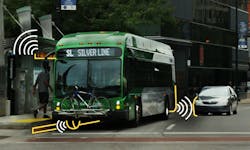Is Autonomous Bus Rapid Transit the Next Evolution of BRT?
Bus rapid transit (BRT) is commonly described as “light rail on wheels.” It combines the qualities of a light rail system, such as speed, efficiency, off-board fare collection, and permanent, well-equipped stations, with the lower costs and locational versatility of a rubber tire system. Simply put, BRT gives buses many of the best qualities of trains without the accompanying price tag.
Though transit professionals generally agree that these qualities give BRT an edge over light rail, some are still considering light rail construction to improve mobility along their communities’ busiest corridors. The primary reason for favoring light rail over BRT is the potential for greater capacity needed on some high-demand routes. Only so many people can fit inside a bus, while train cars are longer and can be joined together to accommodate more riders during peak hours.
Recent advances in autonomous vehicle technology, however, could eliminate this concern and evolve BRT to be more than a light rail mimic. Autonomous bus rapid transit could combine the best of light rail and BRT to set a new standard in public transportation.
Automated Bus Benefits
Autonomous vehicle technology would allow BRT operators to link multiple buses together seamlessly, adapting to demand and adding capacity as needed. Imagine that tomorrow, 40 riders on a high-demand BRT line who all catch the bus at the same stop start leaving work at 5:30 p.m. instead of 5 o’clock. The next day, the operator could easily string two buses together to meet the change in demand. These additional buses would not be physically linked, unlike trains. Rather, the autonomous systems could be calibrated so that the buses traveled inches apart at all times, often traveling in train-like platoons. In theory, autonomous bus rapid transit could scale up to as many vehicles as needed and it would help operators maintain bus headways when there is congestion. Depending on the size of the autonomous buses, current turning restrictions common for larger vehicles and trains, could be alleviated.
Improved safety is another potential benefit of autonomous rapid transit. According to the Federal Transit Administration’s National Transit Database, there were 3,250 collisions, almost 13,000 injuries, and 92 fatalities involving buses in 2011. These figures translated to approximately $483 million in casualty and liability expenses. Autonomous technology would greatly reduce the number of bus-related accidents. Emergency braking systems, which have been shown to have improved reaction times as compared to human drivers, would be engaged automatically when other vehicles, bicyclists or pedestrians were detected as being too close. The systems could also detect potential rear or side impact collisions and adjust the speed or position of the bus to avoid them. Another safety benefit would be for bicyclists, who would not have to deal with the dangers of light rail tracks embedded into the roadway.
BRT includes train-like level boarding, which eliminates the need for riders to climb stairs — a feature that is particularly beneficial for the elderly or users with mobility impairments. Autonomous bus rapid transit, though, would enable true precision docking, allowing buses to get close to the curb consistently, removing the time-consuming task of deploying a boarding extension to bridge the gap between the bus and the platform.
From a cost perspective, capital expenditures would be minor compared to new light rail construction, and the technology could easily be added to existing BRT systems; it could simply be a matter of switching out the equipment instead of purchasing new buses.
Autonomous buses may also not need drivers, reducing operating costs. Instead, these staff could provide control center operations, customer service for the agency, or be dispatched when there are breakdowns. Autonomous buses could also operate in a narrower lane than conventional BRT vehicles, saving on capital costs and allowing BRT to be implemented more easily in confined rights-of-way. For some BRT projects, the need for layovers due to high frequency of service can create issues, but they would be removed or greatly reduced with autonomous buses.
Think about how game changing autonomous bus rapid transit could be if it were paired with some of the innovative BRT projects in the works today, such as IndyGo’s planned Red Line. The Red Line BRT, which CDM Smith is designing, will use a fleet of all-electric, battery-powered buses. Not only would autonomous, all-electric buses improve efficiency, enhance safety and reduce costs, but they would also eliminate emissions and noise, improve urban quality of life and lower the system’s carbon footprint. Similarly, in Seattle where CDM Smith is developing plans for the Madison and Roosevelt corridors, the use of autonomous battery powered-buses would remove the need for new catenary construction and reduce project capital costs.
While these systems are still evolving and are not quite ready for the streets today, autonomous bus rapid transit could soon be the next evolution of BRT—one that provides the best qualities of light rail while providing the most efficient and cost-effective option for moving riders along strategic corridors.
Tim Sorenson, P.E., is a vice president with CDM Smith who has been working on the development of BRT projects since 2000.
